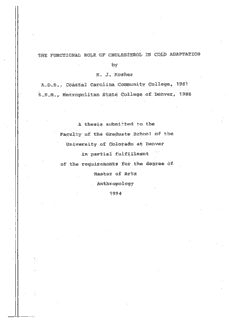
THE FUNCTIONAL ROLE OF CHOLESTEROL IN COLD ADAPTATION by MJ Mosher ADN ... PDF
Preview THE FUNCTIONAL ROLE OF CHOLESTEROL IN COLD ADAPTATION by MJ Mosher ADN ...
THE FUNCTIONAL ROLE OF CHOLESTEROL IN COLD ADAPTATION by M. J. Mosher A.D.N., Coastal Carolina Community College, 1981 B.S.N., Metropolitan state College of Denver, 1986 A thesis submitted to the Faculty of the Graduate School of the Univer~ity of Colorado at Denver in partial fulfillment of the requirements for the degree of Master of Arts Anthropology 1994 This thesis for the Master of Arts degree by M. J. Mosher has been approved for the Department of Anthropology by .' Date Mosher, M. J. (M.A., Anthropology) The Functional Role of Cholesterol in Cold Adaptation Thesis directed by Professor Linda Curran-Everett . ABSTRACT The phenomeni of" se~~onal variatio~ and elevation of serum cholesterol' during exposure to cold climate have been documented in populations since the mid-1920's. The function of" "increased's erum' cholesterol is neither clearly documented~ ~bt~f~lly researched. With cholesterol a now implicated a's major risk factor in cardiovascular disease, much of' it's documented benefit to the human body has bee~"~~-emphasized. The ·intent of this thesis is to explore the hypothesis that elevated serum cholesterol is a functional human adaptive response to cold and to suggest that arbitrary lowering of serum cholesterol in all populations could be detrimental. This thesis is a review of international and interdisciplinary literature of cholesterol research and of human response to cold. The specific cholesterol function investigated is that of 'struc.tural antioxidant' to the cell membrane during periods of cold exposure. iii Evidence, primarily documented in Russian literature, is presented. The research in this area is new and incomplete. However, it suggests a direction for further ,investigation into the relationShip between cold climate and cholesterol. This abstract accurately represents the content of the candidate's thesis. I recommend its publication. Signed Linda Curran-Everett iv CONTENTS CHAPTER PAGE 1. INTRODUCTION •.••••••••••••••••••••••••••• 1 2. ADAPTATION TO COLD ••••••••••••••••••••••• 6 Heat produc_tion .................. ~ ..... 7 Heat loss •••••••• ••••••••••••••••••••• 9 ~ Responses to cold stress ••••••••••••••• 11 Heat conserving behaviors •••••••••••••• 15 Physiological cold adaptations.~ ••••••• 16 Hormonal response to cold •••••••••••••• 21 Human Variation •••••••••••••••••••••••• 26 3. HOMEOVISCOUSADAPTATION •••••••••••••••••• 32 Membrane structure and function •••••••• 33 Cold effects on cells •••••••••••••••••• 36 Homeoviscous adaptation •••••••••••••••• 37 Lipid Peroxidation ••••••••••••••••••••• 42 Population research •••••••••••••••••••• 44 Discussioh ••••••••••••••••••••••••••••• 46 4 • CHOLESTEROL •••••••••••••••••••••••••••••• 49 Transport and metabolism ••••••••••••••• 50 Cholesterol oxidation ••••••••••••••• ~ •• 56 Other fats and lipids •••••••••••••••••• 58 The structural antioxidant ••••••••••••• 60 Discussion ••••••••••••••••••••••••••••• 61 v 5. ADAPTATION ••••••••••••••••••••••••••••••• 64 Factors affecting selection •••••••••••• 66 Coevolution •••••••••••••••••••••••••••• 69 Adaptation as a multi-modal activity ••• 70 Models for study •••••• ; •••••••••••••••• 72 Stress· responses ••• ,• ••••• '• ••••••••••••• ,76 , I Physiological stress responses ••••••••• i78 I The study of adaptation •••••••••••••••• 181 Discussion ••••••••••••••••••••••••••••• 85 6. DISCUSSION AND PROPOSALS ••••• ~ ••••••••••• 87 Revi-ew of studies ••••••••••••••• -. •••••• 87· Proposals for future study •••••••••• ~ •• 94 Conclusion~ •••••• ~.~ ~ 106 F •••• •• ••••••••••• 7. APPENDIX •• '• •••••••••••••••••• ~ ••••••••••• , 08 8. BIBLIOGRAPHY ••••••••••••••••••••••••••••• 11 0 vi FIGURES FIGURE PAGE 1. Thermoregulation .•.••••.•••• ~ •••.•••.•••..••• 12 2. Fluid mosaic for biological membranes~ •.••.• 39 3. Cholesterol transport system ••••••••••.•••.. 51 4. Dyson-Hudson's inclUsive model •• ~ ••••••••••• 73 vii TABLES TABLES PAGE . - 1. Changes in non-shivering thermogenesis during short and long term exposure ••••••• 23 2. Temperature and metabolic responses during all night cold tests •••••••••••••••••••••• 23 3. Transport mechanisms of vital substances •••• 35 4. Apolipoproteins .......... .. ~ ................ . 53 5. Cholesterol percentages ••••••••••••••••.•••• 53 6. Serum cholesterol 1~vels •••• : ••••••••••••••• 88 viii ACKNOWLEDGEMENTS Anssi Arpiainen Liason Officer, TUKOSPAR . Helsinki, Finland Finnish Translator Harriet Mosher Oberlin, Ohio Funding Lena Peschanskaia Department of Economics Graduate Student . UCD Russian Translator Diane Oliver Seattle, Washington . Editor CHAPTER 1 INTRODUCTION Cholesterol is currently denounced for·its potential detrimental effects on the human cardiovascular system. As early as the 1950s medical researchers documented streaky deposits 6f fat and fibe~ in the vascular system of young men. Epidemiologi~ts noted that victims of cardiovascular disease often had high sen,lm cholesterol levels. Health officials r"esponded quickly by declaring war on cholesterol. Doctors developed arbitrary numerical parameters for serum cholesterol . levels and placed individuals into risk categories. International programs to lower serum cholesterol were implemented, despite documented evidence that chol~sterol is so vital to cell viability that virtually every cell in the body manufactures the substanc~. Current epidemiological research associates low serum cholesterol with higher rates of cancer and risk of stroke. Polyunsaturated fats, once thought to be a beneficial exchange for high cholesterol animal fats, are now under investigation for possible detrimental effects on the cardiovascular system and cellular 1
Description: